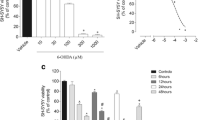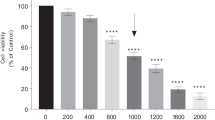Abstract
Parkinson's disease (PD) is an adult-onset neurodegenerative condition caused by oxidative stress and mitochondrial malfunction. In this study, the neuroprotective and neuritogenic activity of water fraction (Sw-fr) containing sorbicillin-like active metabolites of halotolerant P. flavigenum isolated from Salt Lake in Konya, Turkey were investigated on a 6-hydroxydopamine (6-OHDA)-induced PD in vitro PC-12 Adh cell model. Firstly, Sw-fr containing sorbicillin-like active metabolites were extracted from P. flavigenum and was compared with a sorbicillin standard by liquid chromatography-mass spectrometry (LC–MS). Then, the effects of non-cytotoxic concentrations of Sw-fr on the 6-OHDA-induced PD cell model were investigated via real-time cell proliferation analysis using the RTCA DP instrument. The effects of these concentrations on mitochondrial membrane integrity, caspase-3 were investigated by flow cytometry. Neurite outgrowth analysis and immunofluorescence staining were used to explore the neuritogenic effects of neuroprotective doses. By improving PC-12 Adh cell viability, decreasing reactive oxygen species production, and reducing apoptotic cell death, 1 and 10 μg/mL Sw-fr and sorbicillin standard proved neuroprotective against 6-OHDA-induced neurotoxicity. Furthermore, 1 and 10 µg/mL Sw-fr significantly induced neurite outgrowth. As a result, sorbicillin-like active metabolites containing Sw-fr were found to have neuroprotective and neuritogenic effects. Sorbicillin-like metabolites obtained from fungi may be novel natural medicines for neurodegenerative diseases.






Similar content being viewed by others
Data availability
All data generated or analysed during this study are included in this published article (and its supplementary information files).
References
Andersen JK (2004) Oxidative stress in neurodegeneration: cause or consequence? Nat Med 10:S18–S25
Bringmann G, Lang G, Mühlbacher J et al (2003) Sorbicillactone A: a structurally unprecedented bioactive novel-type alkaloid from a sponge-derived fungus. Sponges (Porifera). Springer, New York, pp 231–253
Bringmann G, Lang G, Gulder TAM et al (2005) The first sorbicillinoid alkaloids, the antileukemic sorbicillactones A and B, from a sponge-derived Penicillium chrysogenum strain. Tetrahedron 61:7252–7265
Canturk Z, Kocabiyik E, Ozturk N, İlhan S (2017) Evaluation of antioxidant and antiproliferative metabolites of Penicillium flavigenum isolated from hypersaline environment: Tuz (Salt) Lake by Xcelligence technology. Microbiology 86:346–354
Choi W-S, Eom D-S, Han BS et al (2004) Phosphorylation of p38 MAPK induced by oxidative stress is linked to activation of both caspase-8-and-9-mediated apoptotic pathways in dopaminergic neurons. J Biol Chem 279:20451–20460
Chu Y-F, Chang W-H, Black RM et al (2012) Crude caffeine reduces memory impairment and amyloid β1–42 levels in an Alzheimer’s mouse model. Food Chem 135:2095–2102
Dikmen M, Cantürk Z, Kaya Tilki E, Engür S (2017a) Evaluation of antiangiogenic and antimetastatic effects of Penicillium chrysogenum secondary metabolites. Indian J Pharm Sci 79:49–57. https://doi.org/10.4172/pharmaceutical-sciences.1000200
Dikmen M, Kaya-Tilki E, Engur S, Ozturk Y (2017b) Neuritogenic activity of epigallocatechin gallate and curcumin combination on rat adrenal pheochromocytoma cells. Fresenius Environ Bull 26:4726
Dominguete L, Takahashi JA (2018) Filamentous fungi as source of biotechnologically useful metabolites and natural supplements for neurodegenerative diseases treatment. Chem Eng Trans 64:295–300
Du L, Zhu T, Li L et al (2009) Cytotoxic sorbicillinoids and bisorbicillinoids from a marine-derived fungus Trichoderma sp. Chem Pharm Bull 57:220–223
Eguchi T, Kanai S, Kakinuma K et al (2000) Synthesis of NG-061 and its analogs, and their biological evaluation as an enhancer of nerve growth factor. Chem Pharm Bull 48:1470–1473
Engür S, Dikmen M, Öztürk Y (2016) Comparison of antiproliferative and apoptotic effects of a novel proteasome inhibitor MLN2238 with bortezomib on K562 chronic myeloid leukemia cells. Immunopharmacol Immunotoxicol 38:87–97
Frisvad JC, Filtenborg O (1990) Secondary metabolites as consistent criteria in Penicillium taxonomy and a synoptic key to Penicillium subgenus Penicillium. Modern concepts in Penicillium and Aspergillus classification. Springer, New York, pp 373–384
Frisvad JC, Samson RA (2004) Polyphasic taxonomy of Penicillium subgenus Penicillium. A guide to identification of food and air-borne terverticillate Penicillia and their mycotoxins. Stud Mycol 49:1–174
Gliyazova NS, Ibeanu GC (2016) The chemical molecule B355252 is neuroprotective in an in vitro model of Parkinson’s disease. Cell Mol Neurobiol 36:1109–1122
Grijseels S, Nielsen JC, Nielsen J et al (2017) Physiological characterization of secondary metabolite producing Penicillium cell factories. Fungal Biol Biotechnol 4:1–12
Gunawardena D, Shanmugam K, Low M et al (2014) Determination of anti-inflammatory activities of standardised preparations of plant-and mushroom-based foods. Eur J Nutr 53:335–343
Harned AM, Volp KA (2011) The sorbicillinoid family of natural products: isolation, biosynthesis, and synthetic studies. Nat Prod Rep 28:1790–1810
Iijima T (2006) Mitochondrial membrane potential and ischemic neuronal death. Neurosci Res 55:234–243
Ito M, Tsuchida Y, Mizoue K, Hanada K (1992) NG-011 AND NG-012, novel potentiators of nerve growth factor II. The structure determination of NG-011 AND NG-012. J Antibiot (tokyo) 45:1566–1572
Jaisin Y, Ratanachamnong P, Kuanpradit C et al (2018) Protective effects of γ-mangostin on 6-OHDA-induced toxicity in SH-SY5Y cells. Neurosci Lett 665:229–235
Kaya-Tilki E, Dikmen M, Öztürk Y (2016) Effects of DNMT and HDAC inhibitors (RG108 and trichostatin a) on NGF-induced Neurite outgrowth and cellular migration. Int J Pharmacol 12:351. https://doi.org/10.3923/ijp.2016.351.360
Kim KY, Hwang S-K, Park SY et al (2019) l-Serine protects mouse hippocampal neuronal HT22 cells against oxidative stress-mediated mitochondrial damage and apoptotic cell death. Free Radic Biol Med 141:447–460
Lian Z, Niwa K, Gao J et al (2003) Association of cellular apoptosis with anti-tumor effects of the Chinese herbal complex in endocrine-resistant cancer cell line. Cancer Detect Prev 27:147–154
Lin C-M, Lin Y-T, Lin R-D et al (2015) Neurocytoprotective effects of aliphatic hydroxamates from lovastatin, a secondary metabolite from monascus-fermented red mold rice, in 6-hydroxydopamine (6-OHDA)-treated nerve growth factor (NGF)-differentiated PC12 cells. ACS Chem Neurosci 6:716–724
Liu H, Mao P, Wang J et al (2015) Allicin protects PC12 cells against 6-OHDA-induced oxidative stress and mitochondrial dysfunction via regulating mitochondrial dynamics. Cell Physiol Biochem 36:966–979
Malpure PP, Shah AS, Juvekar AR (2006) Antioxidant and anti-inflammatory activity of extract obtained from Aspergillus candidus MTCC 2202 broth filtrate
Maskey RP, Grün-Wollny I, Laatsch H (2005) Sorbicillin analogues and related dimeric compounds from Penicillium n otatum. J Nat Prod 68:865–870
Meng J, Wang X, Xu D et al (2016) Sorbicillinoids from fungi and their bioactivities. Molecules 21:715
Mustafa AM, Maggi F, Papa F et al (2016) Isofuranodiene: a neuritogenic compound isolated from wild celery (Smyrnium olusatrum L., Apiaceae). Food Chem 192:782. https://doi.org/10.1016/j.foodchem.2015.07.079
Nicolaou KC, Simonsen KB, Vassilikogiannakis G et al (1999) Biomimetic explorations towards the bisorbicillinoids: total synthesis of bisorbicillinol, bisorbibutenolide, and trichodimerol. Angew Chem Int Ed 38:3555–3559
Oxford AE, Raistrick H, Simonart P (1939) Studies in the biochemistry of micro-organisms: griseofulvin, C17H17O6Cl, a metabolic product of Penicillium griseo-fulvum Dierckx. Biochem J 33:240
Phan C-W, David P, Naidu M et al (2015) Therapeutic potential of culinary-medicinal mushrooms for the management of neurodegenerative diseases: diversity, metabolite, and mechanism. Crit Rev Biotechnol 35:355–368
Phan C-W, David P, Sabaratnam V (2017) Edible and medicinal mushrooms: emerging brain food for the mitigation of neurodegenerative diseases. J Med Food 20:1–10
Potashkin J, Seidl SE (2011) The promise of neuroprotective agents in Parkinson’s disease. Front Neurol 2:68
Salo O, Guzmán-Chávez F, Ries MI et al (2016) Identification of a polyketide synthase involved in sorbicillin biosynthesis by Penicillium chrysogenum. Appl Environ Microbiol 82:3971–3978
Visagie CM, Houbraken J, Frisvad JC et al (2014) Identification and nomenclature of the genus Penicillium. Stud Mycol 78:343–371
Wang Y-T, Xue Y-R, Liu C-H (2015) A brief review of bioactive metabolites derived from deep-sea fungi. Mar Drugs 13:4594–4616
Warr GA, Veitch JA, Walsh ANNW et al (1996) BMS-182123, a fungal metabolite that inhibits the production of TNF-α by macrophages and monocytes. J Antibiot (tokyo) 49:234–240
Washida K, Abe N, Sugiyama Y, Hirota A (2007) Novel DPPH radical scavengers, demethylbisorbibutenolide and trichopyrone, from a fungus. Biosci Biotechnol Biochem 71:1052–1057
Acknowledgements
This research was supported by Scientific and Technological Research Council of Turkey (Project Number: 116R006).
Author information
Authors and Affiliations
Corresponding author
Ethics declarations
Conflict of interest
None of the authors had any conflict of interest that could affect the performance of the work or the interpretation of the data.
Additional information
Publisher's Note
Springer Nature remains neutral with regard to jurisdictional claims in published maps and institutional affiliations.
Supplementary Information
Below is the link to the electronic supplementary material.
Rights and permissions
About this article
Cite this article
Kaya Tilki, E., Engür Öztürk, S., Özarda, M.G. et al. Investigation of the neuroprotective and neuritogenic effects of halotolerant Penicillium flavigenum-derived sorbicillin-like compounds on PC-12 Adh cells. Cytotechnology 73, 801–813 (2021). https://doi.org/10.1007/s10616-021-00498-9
Received:
Accepted:
Published:
Issue Date:
DOI: https://doi.org/10.1007/s10616-021-00498-9




